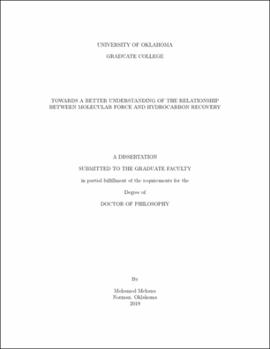| dc.description.abstract | The optimization of hydrocarbon recovery is the core of petroleum engineering. Experiments are always the go-to approach to reveal mysterious observations and verify new theories. However, recent advances on our understanding of the matter have led to the development of computational approaches to track the evolution of its microscopic constituents. The microscopic modelling of the matter can be considered to be a computational experiment. These computational experiments are capable of exploring unknown-physics territories and providing validation to to the hypotheses and theories proposed from macroscopic observations. Coupling the complexity of the subsurface reservoirs with the heterogeneity of hydrocarbon systems, molecular simulation finds a fertile field to offer unmatched insights. The goal of this dissertation is to bridge the gap between theoretical research and field applications facilitating physics-based approaches to augment any observed empirical correlations. In our lab, I have noticed some puzzling observations where experiments are not capable of decoupling the competing factors towards explaining the behavior. For this reason, I designed computational microscopic experiments to unravel previous experimental results.
The density behavior of the CO2/hydrocarbon mixture was my first project. While most of the gases used in the field for Enhanced Oil Recovery (EOR) result in a reduction in density when it mixes with the oil, experiments show that Carbon Dioxide (CO2) can result in an increase of the density. In addition, field operations report an early breakthrough for CO2 flooding, related to gravity segregation due to the abnormal density behavior. However, the molecular interactions that have an impact on the observed macroscopic behavior are poorly understood. I used molecular simulation to study methane, propane and carbon dioxide mixtures with octane, benzene, pentane and hexadecane up to the miscibility limit at temperatures up to 400 K, and pressures up to 6000 psi. The values of density obtained through molecular simulations validate those obtained through experimental work and Equation of State (EoS) methods. Oil-CO2 mixtures sustain their density to a higher gas mole percent compared to other gases, with the density in some cases exceeding the pure liquid hydrocarbon density even when gas density at those conditions is lower. Our results have demonstrated that the intermolecular columbic and induced dipole interactions, and the stretching of the alkane molecules, the proposed mechanisms in literature, might not be the key to understand the oil-CO2 density behavior. However, I find that the molecular size of the gas play an important role in the density profile observed.
Another serious concern for designing a development plan for oil reservoirs is the stability of the asphaltene molecules. I performed molecular simulation to investigate the dynamic behavior of asphaltene during gas flooding, validating the results with experimental observations. I used two structures representing the archipelago and continental types whose aggregation and interactions are studied in methane (C1), propane (C3), CO2, heptane (C7) and toluene as pure solvents, binary mixtures of toluene and either C1, C3 or CO2, and a representative oil composition. A continental structure is used afterwards to evaluate the impact of temperature, pressure, and resin content on the aggregation dynamics in CO2 mixtures. Interestingly, the solvating power of CO2 is dependent on the asphaltene structure where inhibitor-like behavior is observed for continental structure and precipitator-like behavior is observed for archipelago structure. The solvent quality is highly correlated with the solvent's ability to replace the interactions among asphaltene molecules with interactions between asphaltene and solvent. The aggregate size is reduced by temperature and enhanced by pressure in CO2. The aggregation of asphaltene is impacted by the physical state of CO2 as its solvating power to asphaltene is significantly enhanced in its supercritical state.
In another dimension, I investigated Double Layer Expansion (DLE), which is proposed as one of the mechanisms responsible for Improved Oil Recovery (IOR) during Low-Salinity Waterflooding (LSW). I performed molecular simulation to study this phenomenon with both kaolinite and montmorillonite substrates contacting water with a varying concentration of monovalent and divalent ions. My results confirm that the location of the adsorption planes is independent of the ionic strength. However, the electric potential developed on these surfaces and how it decays depends on both the ionic strength and ion nature. A shrinkage is observed in the double layer for the case of low salinity, supported by both film thickness estimations and interaction energy analysis. This shrinkage, which contradicts the prevailing assumption, is consistent with molecular simulation studies reported in the literature, and casts some doubts on the efficiency of double layer expansion as a mechanism for explaining improved oil recovery observed during low-salinity waterflooding. This brings into question the role of double layer expansion in enhancing oil recovery, and raises the need to investigate other mechanisms that could be responsible for the experimental and field observations made in this area. | en_US |
